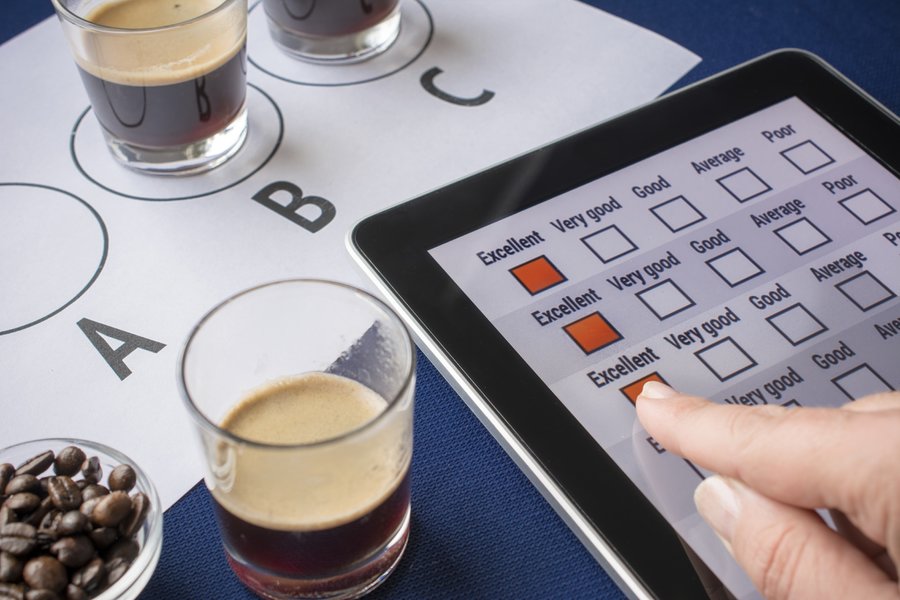ISO 45832 Sensory Aroma Analysis in Coffee
The ISO 45832 standard is a comprehensive guide for sensory aroma analysis of coffee. This method is crucial for quality assurance and product development, ensuring that the aromatic profile of coffee meets consumer expectations. The technique relies on descriptive sensory evaluation by trained panelists who assess various attributes such as intensity, persistence, balance, and complexity.
The process begins with selecting a representative sample of roasted coffee beans or ground coffee. Proper handling is essential to prevent contamination during the extraction phase, which involves grinding the sample into a fine powder if it's not already ground. Extraction can be done using hot water, supercritical carbon dioxide, or other solvents, depending on the specific requirements and desired outcome.
Following extraction, the solution is analyzed by trained panelists who use their senses of smell and taste to evaluate key descriptors like fruity, floral, chocolatey, smoky, etc. This requires a standardized approach where each panelist receives identical samples prepared under controlled conditions. The analysis is qualitative rather than quantitative; it focuses on identifying specific aroma notes that contribute to the overall flavor profile.
The result of this process is not just about detecting flavors but also understanding how they interact and evolve over time. Aroma compounds in coffee are complex, influenced by factors such as bean origin, processing methods, roasting degree, and storage conditions. By applying ISO 45832 guidelines, laboratories can consistently measure these attributes across different batches or varieties of coffee.
This method is particularly valuable for quality control purposes, allowing manufacturers to ensure consistency in their products while also innovating new flavors that appeal to consumers. It’s important to note that sensory analysis should complement other analytical techniques like gas chromatography and mass spectrometry, providing a holistic view of the coffee's aroma.
| Key Aroma Attributes | Description |
|---|---|
| Fruity Notes | Typical descriptors include cherry, apple, or citrus. These notes indicate freshness and quality of the coffee. |
| Floral Fragrances | Suggests a delicate balance in the coffee blend, often associated with high-quality beans from specific regions. |
| Smoky Aromas | Indicate the roasting process and can enhance complexity if done correctly; excessive smoke might be a quality issue. |
| Sweetness | Aroma associated with caramelization during roasting, indicating good roasting conditions. |
Incorporating ISO 45832 into your testing protocols ensures that you meet international standards for sensory evaluation. This approach is particularly beneficial in the food and feed sector where consumer satisfaction and product integrity are paramount. By leveraging this standard, laboratories can provide reliable data to support decision-making processes related to coffee quality assurance.
Scope and Methodology
The scope of ISO 45832 encompasses the sensory evaluation techniques used in assessing the aroma profile of coffee. It specifies the procedures for selecting, training, and managing a trained panel, as well as detailing the steps involved in conducting aroma evaluations.
- Panel Selection: Candidates undergo rigorous selection based on their ability to distinguish and describe aromas accurately.
- Training: Once selected, candidates receive extensive training covering theory, practical skills, and continuous evaluation.
- Evaluation Process: Aroma evaluations follow a structured protocol where samples are presented in a controlled environment. Panelists record their observations using standardized descriptors.
- Data Analysis: The collected data is analyzed statistically to identify trends and patterns, ensuring consistency across multiple evaluations.
The methodology outlined in ISO 45832 ensures that sensory aroma analysis remains objective and repeatable. This standardization is critical for maintaining quality control throughout the coffee supply chain. Laboratories adhering to this method can provide accurate and reliable data that supports various applications, from product development to regulatory compliance.
Benefits of ISO 45832 Sensory Aroma Analysis in Coffee
The implementation of ISO 45832 offers numerous advantages for businesses involved in the food and feed sector, particularly those dealing with coffee. One key benefit is enhanced product quality control. By using standardized methods, laboratories can consistently assess aroma attributes, ensuring that products meet high-quality standards.
Another significant advantage is improved innovation capabilities. With a deeper understanding of aroma profiles, companies can experiment with different roast levels and bean selections to create unique flavor profiles tailored to consumer preferences. This ability to innovate also extends to developing new products or improving existing ones based on sensory feedback.
ISO 45832 supports compliance with international regulations related to food safety and quality assurance. Adhering to this standard demonstrates a commitment to maintaining high standards, which can be beneficial for regulatory bodies and consumers alike. It also fosters trust among stakeholders by providing transparent and reliable data.
In addition to these benefits, ISO 45832 contributes to environmental sustainability by promoting resource-efficient practices during the extraction process. The standard encourages the use of methods that minimize waste while maximizing the extraction yield, ultimately reducing operational costs without compromising product quality.
Quality and Reliability Assurance
The quality and reliability assurance measures associated with ISO 45832 are integral to maintaining consistent and accurate sensory aroma analysis in coffee. These measures ensure that the results obtained are trustworthy and reproducible.
- Precision Training: Regular training sessions for panelists help maintain precision and accuracy in their evaluations.
- Standardized Procedures: Following a set of predefined steps ensures consistency across different evaluation sessions.
- Data Validation: Statistical analysis is used to validate the data collected, ensuring that it aligns with expected outcomes.
- Continuous Improvement: Regular reviews and updates to the methodology help improve the accuracy and reliability of sensory aroma evaluations over time.
These measures not only enhance the credibility of the results but also facilitate better decision-making processes within organizations. By ensuring that every evaluation adheres to these strict protocols, businesses can build confidence in their product quality assurance systems.





